Photo quality comparison: Samsung Galaxy Note 20 versus iPhone 11 Pro
Samsung's latest and greatest smartphones have arrived in the form of the Note 20 and the Note 20 Ultra, so AppleInsider compared their spectacular cameras with Apple's own iPhone line to find the better snapper.
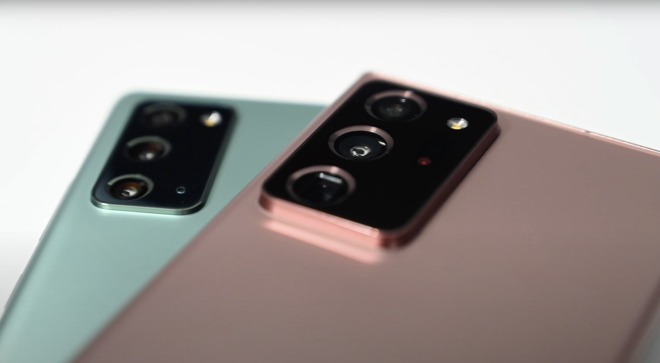
We were thrilled to get our hands on the new Note devices, with Samsung touting some amazing new upgrades for the cameras. Between the high resolution, incredible zoom, and 8K video, there was a lot to check out, so we hit the road to capture some stellar shots that show off the camera's abilities.
While there are some sample images included in the piece, check out the video for all our test shots.
One thing to remember is the iPhones are now roughly a year old, with iPhone 12 inching closer to release. This is still a useful comparison, however, as the iPhone 11 line will be around for some time, and is still the most current iPhone to compare against.
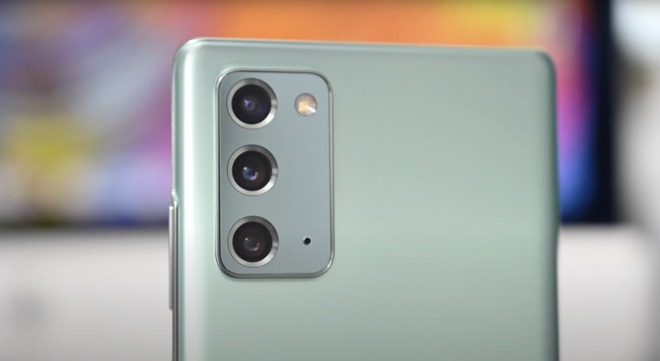 Samsung Galaxy Note 20 has a 12MP ultra-wide, 12MP wide, and 64MP tele
Samsung Galaxy Note 20 has a 12MP ultra-wide, 12MP wide, and 64MP tele
Taking a closer look at the cameras, all devices sport a 12MP ultra-wide angle lens. It's the other lenses where it gets interesting.
The Samsung Galaxy Note 20 sports a 12MP wide-angle lens as well as a 64MP tele lens. Those two lenses combined are able to offer 3X hybrid zoom as well as a maximum of 30X digital zoom.
The Samsung Galaxy Note 20 Ultra is packed with a 108MP wide-angle lens alongside a 12MP tele lens. It is able to obtain 5X optical zoom and 50X digital zoom.
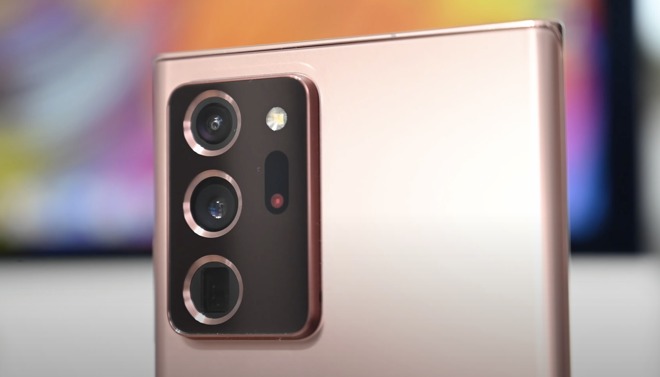 Samsung Galaxy Note 20 Ultra has a 12MP ultra-wide, 108MP wide, and 12MP tele
Samsung Galaxy Note 20 Ultra has a 12MP ultra-wide, 108MP wide, and 12MP tele
It is good to see that Samsung listened to its audience and pulled back from the 100X "super zoom" offered with the S20 line. Photos produced at 100X were grainy at best, and largely unusable.
Apple's iPhone 11 Pro and iPhone 11 Pro Max both have 12MP wide and 12MP tele leness with 2X optical zoom and 10X digital zoom.
It seems each year there are more and more facets to these cameras just in the stock camera apps let alone with third-party apps can pull off. We don't want to spend too much time on all of these, but wanted to give some general impressions of our time using them.
Both phones still include a portrait-like shooting mode, which Apple calls Portrait mode and Samsung calls Live Focus. These haven't changed much since the last phones we tested.
Samsung still leans towards the "fun" side with effects such as swirls of the background as well as the normal blur. Apple has focused very much on replicating real-world lighting effects and as a general rule creates a more polished looking picture.
Which is better depends on which style you prefer.
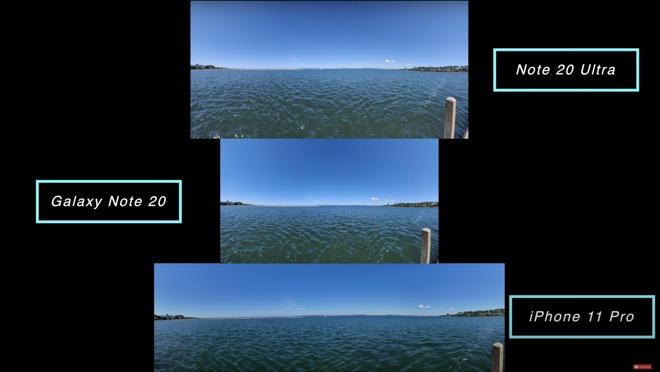 Panoramas shot with each device yield different sized photos
Panoramas shot with each device yield different sized photos
Panoramas are also a common shooting mode. We took a few sample pics across the phones and did our best to keep the same speed each time, yet, the photos ended up entirely different sizes.
The iPhone's picture was the widest while the Note 20 was the most compact, and the Note 20 Ultra was somewhere in between. I prefer the wider look to these, because the more compact the image, the more distortion is apparent in tighter shots.
The wider shots also lend themselves more to large prints.
The final special feature we wanted to touch on was the impressive 108MP mode of the Note 20 Ultra. While it has that many megapixels packed onto the sensor, by default it shoots in a much more reasonable size, but User have the option to enable that massive 108MP resolution if they choose.
When we tested this, it didn't make a huge amount of difference. Not much extra detail was picked up in the shot and you could zoom in a bit more, but at that point you may as well have just used the optical zoom offered by the phone to begin with.
The water images we took looked actually more true to life than the slightly parred back shots found on the iPhone. In the flower shots you can see below, the flowers were so oversaturated they lost a bit of detail and contrast.
In low light shots, such as of our pup Mosby below, the iPhone managed to pull out a bit more detail. Mosby was photographed with a three-second shutter in night mode on all three devices, and the Samsung Note photos look good, but just not quite as crisp.
We also did a seven-second shutter of the night sky. The iPhone again was slightly brighter -- though grainy -- and the Note 20 photos were unusable with almost all black in the images.
The image of our toasted marshmallow porter shows how much better the iPhone nailed focus. The bubbles in the head were super sharp while the Samsung still seems to have issues with the autofocus.
This year, Samsung is using lasers to aid in the focus, but on this picture of a curved cup, the autofocus decided to focus on the front of the clear cup rather than the top ring, the beer's head, or the toasted marshmallow.
In general, the focus system does seem improved over the Galaxy S20.
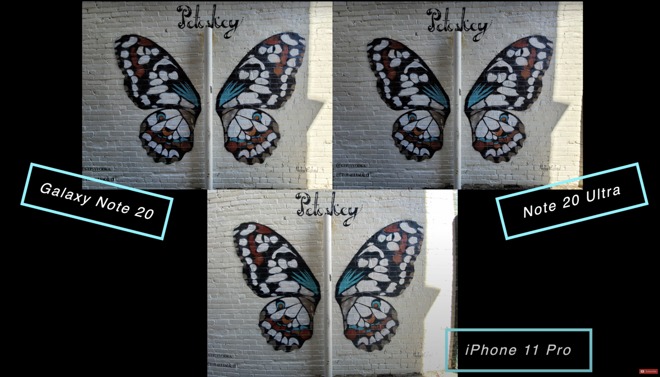 In this alley shot, the iPhone had better exposure
In this alley shot, the iPhone had better exposure
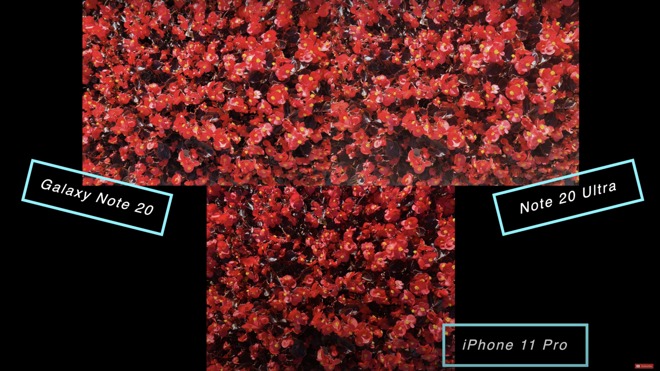
These flowers lacked contrast and were oversatured on both Note images
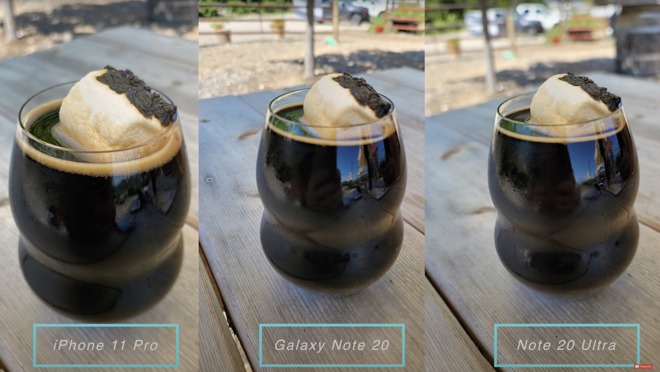 The Note's focus was an issue here, focusing on the front left of the cup rather than the top
The Note's focus was an issue here, focusing on the front left of the cup rather than the top
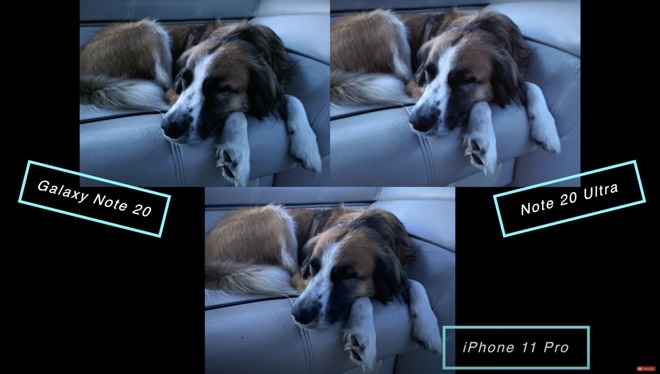 The iPhone had better performance here in low light with more detail on Mosby
The iPhone had better performance here in low light with more detail on Mosby
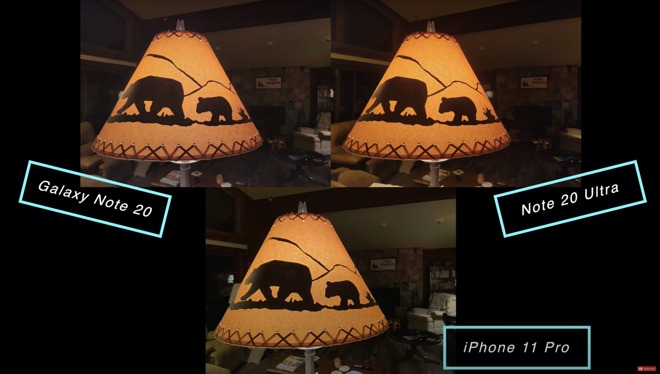 Low light shot of an indoor lamp
Low light shot of an indoor lamp
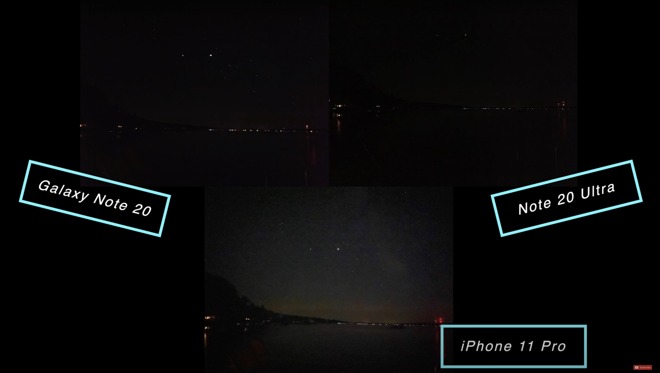 Night sky looked good, though the Ultra skewed the white balance
Night sky looked good, though the Ultra skewed the white balance
 The Note shots looked more true to life in this water shot
The Note shots looked more true to life in this water shot
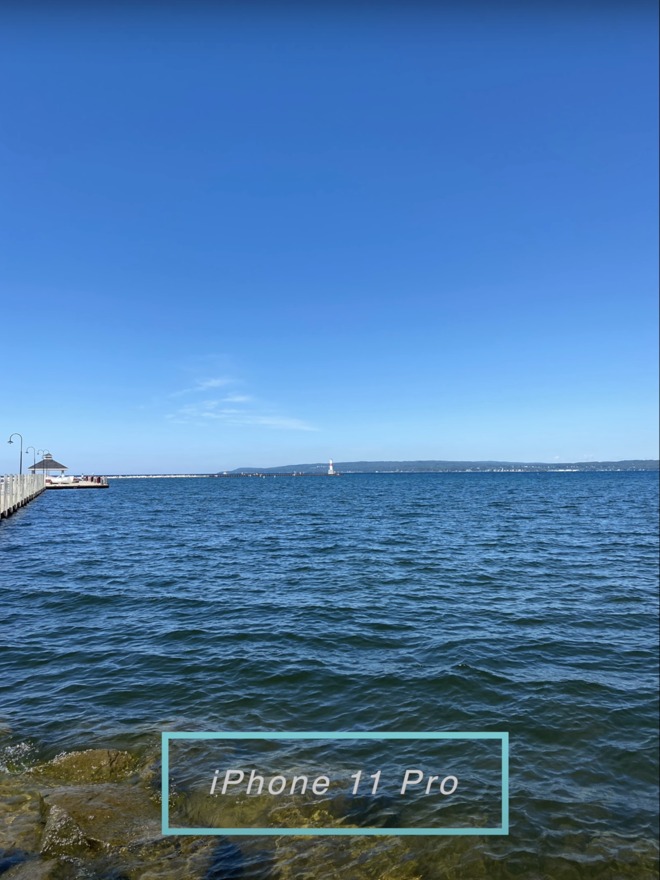
Our far away subject shot at 1X for our zoom test
In our samples, we shot a lighthouse that was a significant distance away. Our iPhone photograph at 10X looked just okay, but the Note 20 at 10X was far better due to its hybrid zoom and higher resolution tele lens.
The 50X shot from the Note 20 Ultra was sharpest at that level, though it too started to lose definition.
 iPhone zoomed to 50X compared to Note 20 Ultra at 50X is a no-brainer
iPhone zoomed to 50X compared to Note 20 Ultra at 50X is a no-brainer
When we were zoomed into 50X and looked at a target that far away, it became increasingly difficult for us to keep the subject in the shot, which makes this level of zoom useless in moving situations.
 Note 20 at 30X compared to iPhone at 30X shows how far ahead Samsung is
Note 20 at 30X compared to iPhone at 30X shows how far ahead Samsung is
We wanted to test the zoom capabilities once more, so we took some pics at a bevy of kites flying through the air. When zoomed to 50X, the iPhone's pictures were a distorted mess, while the Galaxy Note 20 Ultra was very easy to discern what we were looking it.
It may not be sharp enough to do anything with, but in some situations, it can create very usable photos.
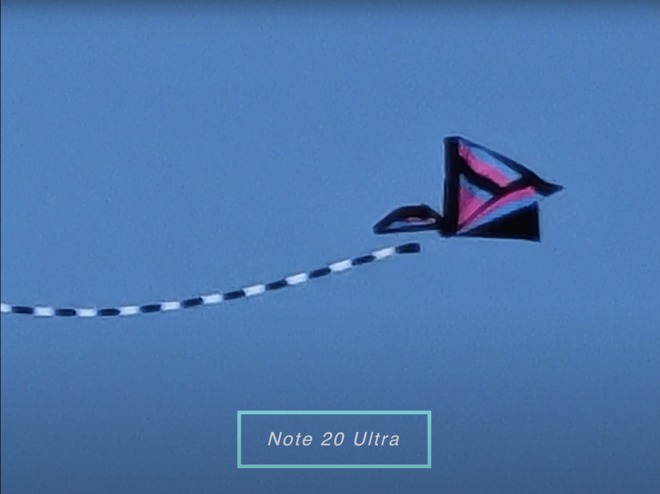 The Note 20 Ultra at 50X is even better than both
The Note 20 Ultra at 50X is even better than both
Apple's pro cameras definitely start to look antiquated compared to these new incredible tele capabilities on Samsung's latest phones.
It is true that there aren't many 8K TVs or monitors in people's homes, but when shooting in 8K, you can crop in the video to still maintain at least 4K resolution. You're limited to only 24 frames per second on the Notes but that is more than enough, making it a potentially invaluable tool for mobile filmmakers.
On iPhone, we are still limited to 4K at 60 frames per second. Fingers crossed we see improvements in this area on the upcoming iPhone 12.
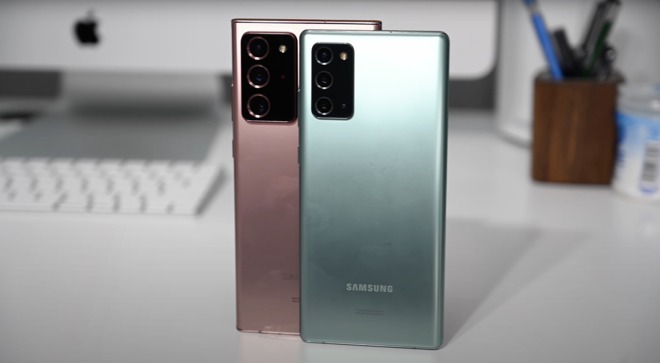
The Samsung Galaxy Note 20 and Note 20 Ultra
Samsung knocks it out of the park with the tele capabilities here. Some extreme zoom shots may be too distorted to be usable but even the 10X images look far better than the iPhone's 10X images.
Apple very much needs to step up its game when it comes to the zoom. Apple's strategy seems to be prioritizing your typical shots and the wide-angle lens, but if you want anything past 5X, the images very much begin to suffer in this comparison.

We were thrilled to get our hands on the new Note devices, with Samsung touting some amazing new upgrades for the cameras. Between the high resolution, incredible zoom, and 8K video, there was a lot to check out, so we hit the road to capture some stellar shots that show off the camera's abilities.
While there are some sample images included in the piece, check out the video for all our test shots.
A look at the specs
For this comparison, we'll be taking a look at the Galaxy Note 20, the Galaxy Note 20 Ultra, as well as the iPhone 11 Pro. The iPhone 11 Pro and iPhone 11 Pro Max have the same lens setup, so photos taken with one will look the same as if shot on the other.One thing to remember is the iPhones are now roughly a year old, with iPhone 12 inching closer to release. This is still a useful comparison, however, as the iPhone 11 line will be around for some time, and is still the most current iPhone to compare against.
 Samsung Galaxy Note 20 has a 12MP ultra-wide, 12MP wide, and 64MP tele
Samsung Galaxy Note 20 has a 12MP ultra-wide, 12MP wide, and 64MP teleTaking a closer look at the cameras, all devices sport a 12MP ultra-wide angle lens. It's the other lenses where it gets interesting.
The Samsung Galaxy Note 20 sports a 12MP wide-angle lens as well as a 64MP tele lens. Those two lenses combined are able to offer 3X hybrid zoom as well as a maximum of 30X digital zoom.
The Samsung Galaxy Note 20 Ultra is packed with a 108MP wide-angle lens alongside a 12MP tele lens. It is able to obtain 5X optical zoom and 50X digital zoom.
 Samsung Galaxy Note 20 Ultra has a 12MP ultra-wide, 108MP wide, and 12MP tele
Samsung Galaxy Note 20 Ultra has a 12MP ultra-wide, 108MP wide, and 12MP teleIt is good to see that Samsung listened to its audience and pulled back from the 100X "super zoom" offered with the S20 line. Photos produced at 100X were grainy at best, and largely unusable.
Apple's iPhone 11 Pro and iPhone 11 Pro Max both have 12MP wide and 12MP tele leness with 2X optical zoom and 10X digital zoom.
Photo tricks
Portrait mode, 108MP mode, live focus, panorama,It seems each year there are more and more facets to these cameras just in the stock camera apps let alone with third-party apps can pull off. We don't want to spend too much time on all of these, but wanted to give some general impressions of our time using them.
Both phones still include a portrait-like shooting mode, which Apple calls Portrait mode and Samsung calls Live Focus. These haven't changed much since the last phones we tested.
Samsung still leans towards the "fun" side with effects such as swirls of the background as well as the normal blur. Apple has focused very much on replicating real-world lighting effects and as a general rule creates a more polished looking picture.
Which is better depends on which style you prefer.
 Panoramas shot with each device yield different sized photos
Panoramas shot with each device yield different sized photosPanoramas are also a common shooting mode. We took a few sample pics across the phones and did our best to keep the same speed each time, yet, the photos ended up entirely different sizes.
The iPhone's picture was the widest while the Note 20 was the most compact, and the Note 20 Ultra was somewhere in between. I prefer the wider look to these, because the more compact the image, the more distortion is apparent in tighter shots.
The wider shots also lend themselves more to large prints.
The final special feature we wanted to touch on was the impressive 108MP mode of the Note 20 Ultra. While it has that many megapixels packed onto the sensor, by default it shoots in a much more reasonable size, but User have the option to enable that massive 108MP resolution if they choose.
When we tested this, it didn't make a huge amount of difference. Not much extra detail was picked up in the shot and you could zoom in a bit more, but at that point you may as well have just used the optical zoom offered by the phone to begin with.
Every day shooting
For your normal, everyday shots, these cameras compared quite well. Samsung still has the slightly oversaturated look it is known for, and in some shots, this worked out OK.The water images we took looked actually more true to life than the slightly parred back shots found on the iPhone. In the flower shots you can see below, the flowers were so oversaturated they lost a bit of detail and contrast.
In low light shots, such as of our pup Mosby below, the iPhone managed to pull out a bit more detail. Mosby was photographed with a three-second shutter in night mode on all three devices, and the Samsung Note photos look good, but just not quite as crisp.
We also did a seven-second shutter of the night sky. The iPhone again was slightly brighter -- though grainy -- and the Note 20 photos were unusable with almost all black in the images.
The image of our toasted marshmallow porter shows how much better the iPhone nailed focus. The bubbles in the head were super sharp while the Samsung still seems to have issues with the autofocus.
This year, Samsung is using lasers to aid in the focus, but on this picture of a curved cup, the autofocus decided to focus on the front of the clear cup rather than the top ring, the beer's head, or the toasted marshmallow.
In general, the focus system does seem improved over the Galaxy S20.
 In this alley shot, the iPhone had better exposure
In this alley shot, the iPhone had better exposure
These flowers lacked contrast and were oversatured on both Note images
 The Note's focus was an issue here, focusing on the front left of the cup rather than the top
The Note's focus was an issue here, focusing on the front left of the cup rather than the top The iPhone had better performance here in low light with more detail on Mosby
The iPhone had better performance here in low light with more detail on Mosby Low light shot of an indoor lamp
Low light shot of an indoor lamp Night sky looked good, though the Ultra skewed the white balance
Night sky looked good, though the Ultra skewed the white balance The Note shots looked more true to life in this water shot
The Note shots looked more true to life in this water shotTele capabilities
Where Samsung really shines is with the telescopic capabilities of its new devices. Both the Note 20 and the Note 20 Ultra blow away Apple in terms of picture quality.
Our far away subject shot at 1X for our zoom test
In our samples, we shot a lighthouse that was a significant distance away. Our iPhone photograph at 10X looked just okay, but the Note 20 at 10X was far better due to its hybrid zoom and higher resolution tele lens.
The 50X shot from the Note 20 Ultra was sharpest at that level, though it too started to lose definition.
 iPhone zoomed to 50X compared to Note 20 Ultra at 50X is a no-brainer
iPhone zoomed to 50X compared to Note 20 Ultra at 50X is a no-brainerWhen we were zoomed into 50X and looked at a target that far away, it became increasingly difficult for us to keep the subject in the shot, which makes this level of zoom useless in moving situations.
 Note 20 at 30X compared to iPhone at 30X shows how far ahead Samsung is
Note 20 at 30X compared to iPhone at 30X shows how far ahead Samsung isWe wanted to test the zoom capabilities once more, so we took some pics at a bevy of kites flying through the air. When zoomed to 50X, the iPhone's pictures were a distorted mess, while the Galaxy Note 20 Ultra was very easy to discern what we were looking it.
It may not be sharp enough to do anything with, but in some situations, it can create very usable photos.
 The Note 20 Ultra at 50X is even better than both
The Note 20 Ultra at 50X is even better than bothApple's pro cameras definitely start to look antiquated compared to these new incredible tele capabilities on Samsung's latest phones.
Video
This camera comparison was particularly focused on the photo capabilities, but we have to at least mention video. We toyed around with this a bit and are so excited by the prospect of incredible 8K video recording coming to smartphones.It is true that there aren't many 8K TVs or monitors in people's homes, but when shooting in 8K, you can crop in the video to still maintain at least 4K resolution. You're limited to only 24 frames per second on the Notes but that is more than enough, making it a potentially invaluable tool for mobile filmmakers.
On iPhone, we are still limited to 4K at 60 frames per second. Fingers crossed we see improvements in this area on the upcoming iPhone 12.
So which is the better shooter?
Picking a winner here is hard. In everyday shots, we leaned a bit towards the iPhone the less saturated images, better focus, and better portrait mode. The overall tone of the image though can be adjusted after the fact, so if it is a white balance, contrast, or saturation issue, that can all be tweaked a bit after.
The Samsung Galaxy Note 20 and Note 20 Ultra
Samsung knocks it out of the park with the tele capabilities here. Some extreme zoom shots may be too distorted to be usable but even the 10X images look far better than the iPhone's 10X images.
Apple very much needs to step up its game when it comes to the zoom. Apple's strategy seems to be prioritizing your typical shots and the wide-angle lens, but if you want anything past 5X, the images very much begin to suffer in this comparison.


Comments
Not that it matters to me at all, still rocking the SE Classic. Might upgrade to the 7 or 8 soon tho.
That's always the case and I hate to admit but it's fair. You can't compare a knockoff iPhone to the real thing, THAT would be unfair. So best to compare an old model to the latest one.
Samsung once had an ad comparing a 4 year old iPhone to their latest iKnockoff. The fine print read something like: "Shown is an old version of iPhone and iOS. New versions are better."
Third: When it comes to taking normal pictures, I think the article shows clearly that the iPhone 11 is still king of the hill by a good margin in the quality of normal photos and panoramas. But it is interesting to note that Samsung has done some quality work here with regards to digital zoom (presumably using AI/ML in post-processing) that I hope Apple will adopt in the iPhone 12. I think the 8K video feature of the S20 Ultra is a gimmick that just eats up your storage for no sound reason, but the day is coming where Apple will need to at least offer 8K video and I hope they are doing the research into the algorithms needed to create that level of video without having to attach a separate (USB-C?) SSD just to accommodate the file sizes.
Listening to him say “ex“ throughout the video drove me absolutely batty. It’s just simply sounded so unintelligent. not to mention he talks quickly and doesn’t annunciate which makes it really hard to understand what he was saying at times.
I kind of feel if you were going to review photography, you should understand the terminology and what you’re talking about. Can I assume the 5X optical zoom Image is used to get the 50X digital zoom image? In other words, it really is just a 5X image digitally blown up, hence the added resolution. That’s kind of an important thing to point out.
It will be interesting to see if they expand the second tier of the product line beyond SE. Will they convert 11 into filling the spot Xr has?
Many of us who are very keyed into the technical aspects of devices and the market sometimes forget we are generally not who they are primarily designing for and marketing to. The vast majority just wants as much of the latest and greatest they can figure out a way to pay for. Technophiles are influencers, but not even close to the bulk of the market.
Regardless, I think Apple Insider is just filling the page on a weekend and don't understand the editorial purpose of comparing the new released Samsung flagship to what we know will lose its perch at the top of the iPhone line with in a few weeks. I feel pretty confident they will be reissuing almost the exact same article shortly after 12 is announced. The tech media will get the phone right after the announcement, well before consumers will get deliveries.
Competition is good. I just don't think the two phones in the article are really competing. It's kind of like marketing a 2019 car after you have announced the 2020 version with significant upgrades. Without incentives who is buying the 2019 version?
Also, I hate to be pedantic, so consider this friendly, constructive criticism... In a piece focusing on camera performance, I think we should make a better effort to get the terminology right. First, lenses don't have "megapixels". If each lens is paired with a separate sensor with different specs, then just say so, or simply refer to the different 'cameras' without conflating the two. And second, when speaking of digital images the term 'grain' shouldn't be used interchangeably with 'noise'. The former is an artifact seen in film while the latter is associated with digital images.
If a $1300 phone becomes "yesterdays technology" in a year, I made a bad choice a year ago!
Currently, you have to use Chrome to get 4K video, especially important for things like photo and video comparisons.
If the purpose of the shoot-off is to advise on purchasing decisions, I would certainly wait a few weeks and see what the new version offers.
The wide angles seem minimally mentioned, yet was that a significant new feature of the iPhone 11?
The alley shot (any brick wall may be helpful) starts to illustrate edge/corner sharpness and barrel distortion (correction). Some shots with lights might be helpful to assess chromatic aberration... I also ask about what seems extreme cropping of the iPhone 11 video in ultra wide mode, presumably for motion stabilization, yet is that needed with an ultra wide, or should it be user selectable, and how might that compare to the S20...?
Examples of a more technical analysis including lab tested blur index comparisons:
www.imaging-resource.com/lenses/olympus/15mm-f8-bcl-1580-body-cap-lens/review/
www.imaging-resource.com/lenses/nikon/1-10mm-f2.8-nikkor/review/
www.imaging-resource.com/lenses/canon/ef-14mm-f2.8l-usm/review/
I would vote in favor of "Apple very much needs to step up its game" - iPhones' camera specs have not improved as much as they should have in recent years; they should never be playing catch-up to the likes of Samsung (>>shudder<<). Although I would still choose iPhone over these Samsungs by virtue of the color fidelity alone (Samsung is over-saturated/fake, in most of these, in comparison to iPhone - that's where Apple has, astutely, stayed the course). I have delayed upgrading from my IP6 specifically because I haven't seen enough difference in the cameras' image quality. (I'm a professional photo editor and I carry around a pocket Sony RX100V if I want an actually-good capture rather than just a snapshot). Yes, it's gotten better, but not enough to purchase a $1000+ device to replace a device that stills works perfectly well, even on the camera specs alone. IP12's 5G may push me over the edge, but not if the battery life is downgraded, and I'm not convinced 5G is anything but a marketing gimmick for a few more years.
And all the gushing over "8K" video. The only people who have any business shooting 8K are the highest-end videographer professionals, for very specific applications, none of them mass-market relevant, much less personal-tech relevant, and you can bet they would use tech with advanced lens specs. If you shot an 8K video on a phone it would fill up your phone's entire memory card in about 60 seconds (I'm guessing, but still...). And for what purpose? Seriously, if someone can enlighten me what possible reason a non-videographer/professional would need to shoot 8K (other than bragging rights), I'm all ears.